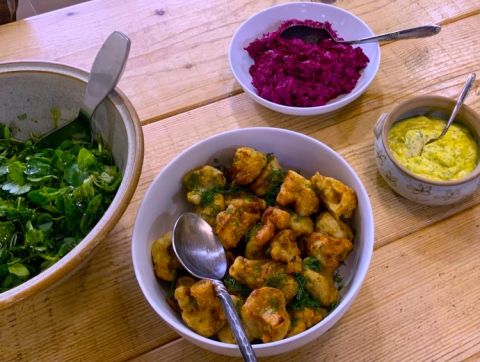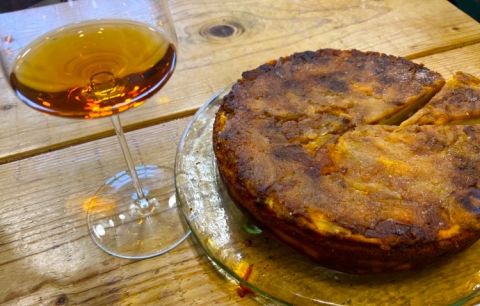#CookForUkraine and drink for Georgia

See also Letters from Kyiv for news from Ukraine, details of the #CookForUkraine campaign initiative, and check out this weekend's wine-themed online auction for Ukraine.
It took just a couple of days for Ukrainian Olia Hercules and Russian Alissa Timoshkina to comprehend the shock and horror of the Russian invasion of Ukraine before the two of them swung into action. With the help and experience of Clerkenwell Boy (who was behind #CookForSyria) and humanitarian Layla Yarjani, the global #CookForUkraine campaign was launched.
Olia Hercules comes from Kakhovka in the south of Ukraine. She came to the UK for university, settled in London, became a journalist, and then retrained as a chef at Leiths School of Food and Wine. She's cooked for Ottolenghi and has written three cookbooks, all about food from Eastern Europe. Her most recent book, Summer Kitchens: Inside Ukraine's hidden places of cooking and sanctuary, was published in 2020. I have a copy – it's a wonderful cookbook. Her storytelling is as evocative and delicious as the recipes look and sound.
Alissa Timoshkina, who grew up in Siberia, also came to London to study, and also never left. She turned her PhD in film history and her love of food into a supper club, which she started in 2015. KinoVino entwined cinema and food in an itinerant pop-up style and was highly successful, winning awards and much acclaim before the pandemic closed it down (although there is now a virtual, DIY version – very post-COVID). These days she holds cooking classes (so far devoted to Russian cuisine) and in 2021 published her first book, Salt & Time: Recipes from a Russian kitchen.
Long before the war, both of them were championing their regional food, challenging misconceptions that it's all boiled cabbage and borscht. They were both strong believers in the power of food to bring people together and break down barriers, using the medium of food to tell stories rather than promote themselves. The aim of #CookForUkraine is not only to raise funds for displaced Ukrainians, but also to support, connect and show solidarity. Timoshkina writes on the JustGiving page, 'Today, more than ever, I feel how important food is to our understanding of the world around us! As my heart breaks for the children and families impacted by this conflict. Like millions of Russians, I too have Ukrainian roots, and grew up on a beautiful diet of Ukrainian and Russian dishes. These countries have shared a complex and rich history, and the culinary language reflects this relationship in the most powerful and relatable way … Let’s cook for peace, for freedom, for truth, for common sense, for rational thought and for love.'
Hercules and Timoshkina are asking people to get cooking, host supper clubs using the Ukrainian and Eastern European recipes on the website, hold a bake sale, tell their stories and share pictures on social media. Restaurants, hotels and bars are being asked to include an Eastern European dish on their menus and donate the proceeds, or add a voluntary donation to their customer's bills.
Having registered with five charities in the hopes of being able to take in a refugee family, with no contact from any of them (swamped as they are by offers from the British public, and hamstrung by the incomprehensible red tape choking the refugee-visa application process), I was feeling sick with helplessness. So I commandeered the talents of my sister, a chef at Petersham Nurseries (also, like Olia Hercules, Leiths trained), to #CookForUkraine, and we put our heads together to come up with a menu and wines to match.
We chose to pair it with Georgian wines (sourced through Sarah Abbott MW – thank you, Sarah!), whose people are showing solidarity with Ukraine borne of bitter experience, because of the natural synchronicity between Georgian wines and the colourful, seasonal, fermentation-driven, zesty, wholesome, down-to-earth embrace of Ukrainian food.
The menu
Starter
Kuchmachi – chicken gizzards, hearts and liver with pomegranate
with
Ukranina Jewish challah bread and lamb's lettuce
Mains
Holubtsy – pork- and beef-stuffed cabbage leaves
or
Vegetarian holubtsy – buckwheat-stuffed cabbage leaves
with
Cauliflower fritters and creamy beet salad
Dessert
Sernyk – curd cake with caramelised apples
Trust me that this orderly menu in no way resembles the chaos in my kitchen when two professional chefs (one Zimbabwean and one Bulgarian workmate of hers who sacrificed his day off to drive up to the wilds of north Buckinghamshire) took on the task of cooking a three-course meal with little time to prepare and not much room to manoeuvre, especially as one of them (my sister) is on crutches. My sister, I might add, is what one could describe as flamboyant in her cooking methods. After one culinary marathon, I found myself wiping ingredients from the ceiling, walls, kettle and light switches. But she is, in her defence, a formidable chef, and thanks to the calm assistance of her co-chef, we got there in the end.
The kuchmachi starter was my favourite dish of the whole meal. Sonorously deep flavours, caramelised and sticky, but electrified by the sharp, bright tang of pomegranate and the delicate contrast of crunchy nuttiness. It needed the gentle green of the lamb's lettuce. The challah bread was pure indulgence, not needed except to mop up the last of the sticky juices, but its sweet density was hard to resist (especially slathered with butter…). It was also the most interesting dish to pair with wine. My instinct was to go with the Ch Askana Chkhaveri rosé, with its dry, meaty tang. And that worked well. But then, on a whim, we tried it with the slightly crazy, port-like Papari Valley, 3 Qvevri Terraces Saperavi, and, kerpow! This succulently rich and powerful wine almost swooned in the arms of the kuchmachi! The two could not be separated. The rosé, in more ways than one, was pale by comparison. Incidentally, the almost black-looking Binekhi Qvevri Otskhanuri Sapere also showed good pairing potential, but the kuchmachi and Papari had eyes for no one else.
Both holubtsy dishes (also spelt holubtsi and, in Russia, golubtsy), vegetarian and meat, were very similar in flavour. You'd think that cabbage stuffed with buckwheat is going to be one pretty plain peasant dish, but don't be deceived. In the meat version, the richness of the pork and beef contrasts with the intense, piquant sharpness of the barberries (don't leave them out – they really do make the dish!) and the sauce also has a sweet, umami intensity that makes the dish unexpectedly exciting, while being comforting and wholesome at the same time. It's even better with a generous dollop of fresh-dill-flecked sour cream. With both these dishes, the star pairings were undoubtedly the amber, skin-contact wines. My favourite match, especially with the buckwheat holubtsy, was the very salty, insanely umami Archil's Wine Rkatsiteli. But everyone around the table also loved Kartlis Valley's Qvevri Amber Kisi, and I agree that it might have had the edge over the Rkatsiteli when it came to the traditional holubtsy. Perhaps it was the tannins? The reds overpowered both dishes and after one small sip, we moved those two bottles to one side.
When it came to the side dishes, however, it was the turn of Nebi's dry white Chinuri to shine. Something about the summer-garden spice-and-green of this unfiltered, skin-contact, qvevri-made white resonated with the earth-centred flavours of crisp-fried cauliflower dipped in a lemony garlic mayonnaise, fragrant with fresh dill, and the vibrantly pink, sweet-root beets slathered in sour cream. I could have quite happily taken both the cauliflower fritters and beetroot salad into the garden, with the Chinuri, and eaten them as a meal in themselves, with nothing but my grinning sun-buttered daffodils for company.
I can't give Nebi all the glory. There was one other wine that was also very good with the cauliflower fritters in particular, and that was Ch Askana's seductive honeysuckle-and-kumquat Tsolikouri. The silk-and-crunchy sensation, followed by a sip of this voluptuous wine, was so good I almost felt guilty.
Dessert was a cheesecake that is traditional in both Poland and Ukraine, but Olia Hercules has tweaked the usual sernyk recipe by adding caramelised apples and adapting it to ricotta, which is not as dry as the farmer's cheese usually used to make it. It wasn't an overly sweet dessert, the Bramley apples we used giving the cheesecake just a tiny bit of an edge. Hercules suggests having it with a cup of unsweetened tea and lemon. Teliani Valley's Khakuri No 8, a skin-contact blend of Rkatsiteli, Kakhuri Mtsvane, Khikhvi and Kisi, which came with determined acidity, bitter citrus and a nutty chew, proved to be a very acceptable substitute.
If you're looking for more Ukraine recipe inspiration, Alissa Timoshkina's blog has some amazing recipes (with mouth-watering photographs to tempt even the most reluctant cook) and there are also good ideas on the #CookForUkraine Instagram page. If you'd rather just focus on wine, see this weekend's wine-themed online auction for Ukraine.
All photos are mine except for the main image by Elena Mozhvilo, from Unsplash.
Become a member to view this article and thousands more!
- 15,415 featured articles
- 274,312 wine reviews
- Maps from The World Atlas of Wine, 8th edition (RRP £50)
- The Oxford Companion to Wine, 5th edition (RRP £50)
- Members’ forum
- 15,415 featured articles
- 274,312 wine reviews
- Maps from The World Atlas of Wine, 8th edition (RRP £50)
- The Oxford Companion to Wine, 5th edition (RRP £50)
- Members’ forum
- Commercial use of our Tasting Notes





